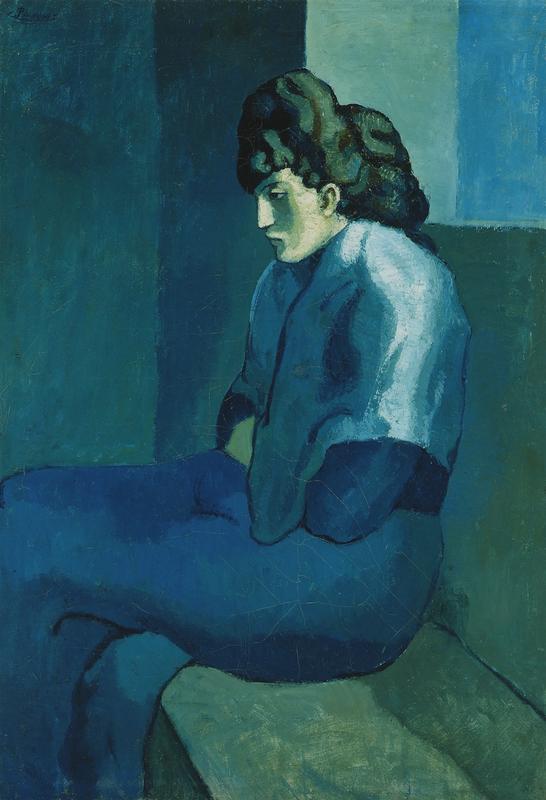More about Melancholy Woman
- All
- Info
- Shop

Contributor
Before his "Rose Period," Pablo Picasso dabbled with various shades of blue.
Melancholy Woman is one of several paintings that came out of the artist's famed Blue Period. This period came early in the painter’s young life, following the death of his friend, Catalan painter and poet Carles Casagemas. Picasso was only 19 when Casagemas shot himself, and from 1901 to 1904, Picasso saw the world in shades of deep, intense blue.
The friendship between Picasso and Casagemas was the real deal. The pair traveled together from Barcelona to Paris to practice art and mingle with various artists and other modern thinkers. They seemed to have it all until Casagemas was rejected by a young woman by the name of Germaine, and shot himself with a bullet after being spurned (but not before shooting at poor Germaine herself, though luckily she was not hit). While the pair were tight buds, Picasso wasn’t present to stop Casagemas from doing the unthinkable. Struggling financially, Picasso had been moving back and forth between Spain and France, and at the time of Casagemas’s tragedy, Picasso was in Madrid.
After his friend's death, Picasso mourned the loss by renting out the studio he and Casagemas painted in together and by visiting the café where Casagemas killed himself. It didn’t help that Picasso's sales remained slow, and he plummeted deeper into depression. He would go on to project his feelings onto paintings like Melancholy Woman and The Life. The woman in Melancholy Woman has folded into herself so many times it seems she’s lost her arms and legs, a closed off pose that can be understood as expression of Picasso's own feelings of misery, loss, and isolation.
During this glum period, Picasso turned his creative focus to those who existed in the margins of society: the poor, the sick, the downtrodden, the ones who were most unlucky. What better place to look for these subjects than in a prison? It's thought that the austere room shown here is a prison cell at the Saint-Lazare women’s prison in Montmartre. Picasso visited Saint-Lazare several times between 1901-1902 to draw the women there, many of whom were prostitutes.
Melancholy Woman remained part of French art dealer Paul Guillaume’s inventory until his finances began to sour (thanks Great Depression!), and he sold the painting to Robert Tannahill in 1934, who eventually gave it to the Detroit Museum where it now resides. Interestingly, while paintings from the Blue Period are now priceless treasures for museums across the world, Picasso and his critics believed these works to be overly sentimental.
Sources
- Boddewyn, Julia May. “Valentine Dudensing and the Valentine Gallery: Selling the United States on the School of Paris,” Pioneers of the Global Art Market. Edited by Christel H. Force. London, GB: Bloomsbury Visual Arts, 2020.
- Bunyan, Marcus, “Exhibition: ‘the young Picasso – blue and rose periods’ at Foundation Beyeler, Richen, Switzerland,” Art Blart. Accessed February 22, 2021. https://artblart.com/tag/pablo-picasso-melancholy-woman/
- Charles, Victoria. Pablo Picasso. Parkstone International, 2011.
- Gotthardt, Alexxa, “The emotional turmoil behind Picasso’s Blue Period,” Artsy, December 13, 2017. Accessed February 22, 2021. https://www.artsy.net/article/artsy-editorial-emotional-turmoil-picasso…
- Kern, Thomas, “Picasso’s early work on show in Basel,” Swiss Info, February 6, 2019. Accessed February 20, 2021. https://www.swissinfo.ch/eng/blue-and-rose-periods_picasso-s-early-work…
- Kimmelman, Michael, “First steps on the journey from prodigy to Picasso,” The New York Times, April 11, 1997. Accessed February 22, 2021. https://www.nytimes.com/1997/04/11/arts/first-steps-on-the-journey-from…
- Marcus, Daniel, “Picasso: Blue and Rose,” Artforum. Accessed February 22, 2021. https://www.artforum.com/print/reviews/201901/picasso-blue-and-rose-780…
- Martin, Cristina, “Inhabitants of the museum: Carles Casagemas, the mysterious friend from youth of Picasso,” El Blog del Museu Picasso de Barcelona, July 24, 2014. Accessed February 22, 2021. https://www.blogmuseupicassobcn.org/2014/07/inhabitants-of-the
- Toodehfallah, Anahita, “How Picasso’s Blue and Rose Periods lay the foundation for his art,” Hyperallergic, November 12, 2018. Accessed February 22, 2021. https://hyperallergic.com/469664/picasso-blue-and-rose-musee-dorsay/












